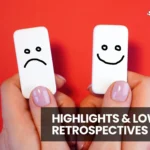In the realm of Agile project management, the art of “story point estimation” plays a pivotal role in ensuring successful outcomes. This article delves into the essence of story points, unraveling their significance in Agile methodologies.
See more: Planning Poker for Jira | The best tool estimating for Agile Projects
Contents
Understanding Story Points
What are the story points?
In Agile project management, story points are a critical metric. They represent the effort required to complete a user story, offering a unique approach to project planning. Unlike traditional methods that rely on time (hours or days), story points use relative estimation. This method considers factors like risk, complexity, and repetition to gauge the effort needed.
For instance, Agile story points often use a modified Fibonacci sequence (1, 2, 3, 5, 8, 13, 20, 40, 100) to provide clear, spaced-apart values, facilitating easier consensus among team members. This relative estimation technique, focusing more on the effort and complexity than on the exact time, sets story points apart from conventional estimation practices.
Benefits of using story points
When it comes to Agile project management, utilizing story points for estimation is a game-changer. Here’s why:
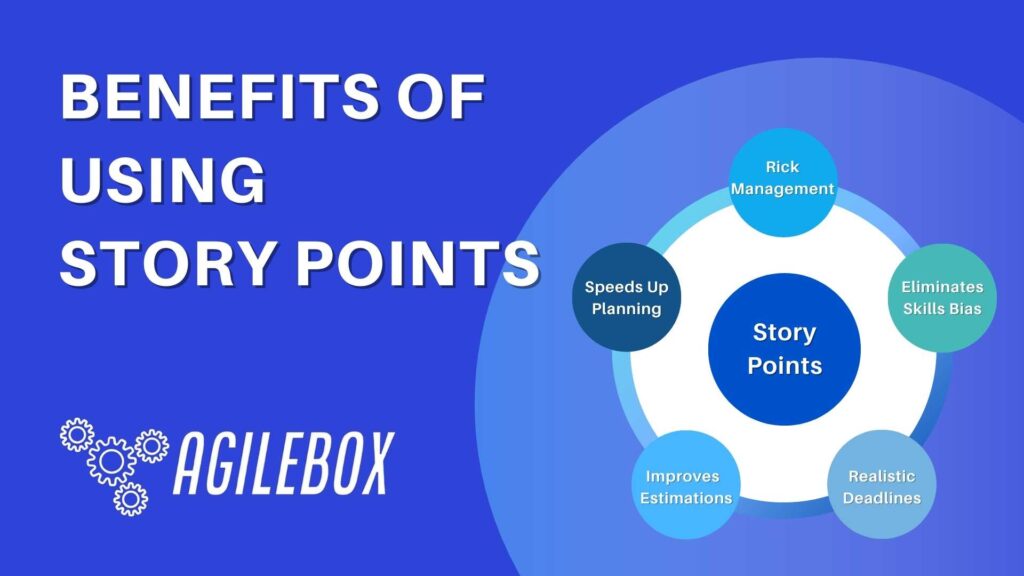
- Speeds Up Planning: Since story points are relative, they are estimated by comparing with similar tasks already evaluated. This relative scoring speeds up the estimation process significantly. It’s like getting better at guessing the time it takes to run a mile after you’ve run a few already.
- Accounts for Uncertainty and Risk: Story point estimation isn’t just about the task itself; it also considers the unpredictability and risk involved. This approach makes planning more robust and realistic.
- Eliminates Skills Bias: Traditional estimation methods can be skewed based on an individual’s experience level. But with story points, estimations are a team effort, reducing bias and fostering unity.
- Leads to More Realistic Deadlines: Unlike arbitrary timeframes often set by traditional methods, story points lead to deadlines that actually make sense, as they’re based on a more nuanced understanding of the work involved.
- Improves Future Estimations: The beauty of story points is their adaptability. As you complete more sprints and gather data, you can refine your story point matrix for even more accurate future estimations.
In short, story point estimation is more than just a number game; it’s about understanding and managing the complexities of Agile projects in a way that’s inclusive, dynamic, and effective.
Why Accurate Story Point Estimation is Important?
Accurate story point estimation is vital in Agile project management. They enable teams to prioritize work more effectively and allocate resources smarter, ensuring smoother project progress.
A well-estimated story point provides a reliable basis for sprint planning and resource allocation. Inaccurate estimations can lead to unrealistic timelines and strained resources.
But here’s the catch: estimating with story points is tricky, often leading to different interpretations among team members. Common pitfalls in story point estimation include underestimating the complexity or overestimating the team’s capacity. This is the essence and challenge of ‘story point estimation’ – a vital skill for Agile teams to master.
Step-by-Step Guide to Estimating Story Points in Agile
Estimating story points in Agile can seem daunting, but with a structured approach and the right tools, it becomes a streamlined process. Here’s a step-by-step guide to estimate story points.
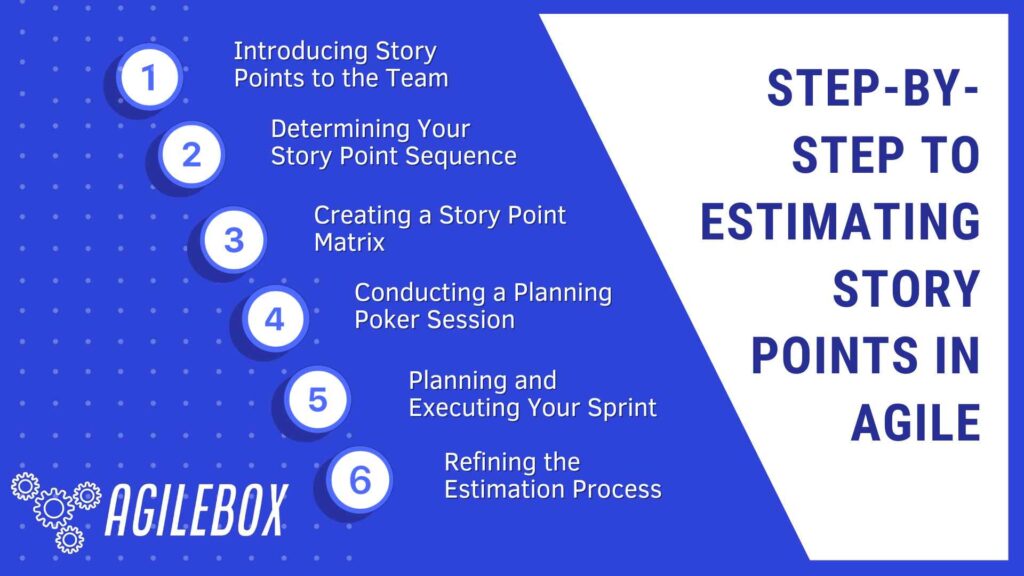
1. Introducing Story Points to the Team
Start by educating your team about story points. Explain that these points represent the relative effort and complexity of tasks, rather than the time taken to complete them. Clarify that in story point estimation, the focus is on how much more effort one task requires compared to another.
2. Determining Your Story Point Sequence
Choose a sequence like the Fibonacci sequence (1, 2, 3, 5, 8, 13, 20, 40, 100) for assigning story points. This sequence helps teams make more nuanced estimations by focusing on the relative difference in effort between tasks. It’s a way to ensure that estimations are not just made arbitrarily but have a consistent scale for comparison.
3. Creating a Story Point Matrix
Develop a matrix that correlates with your chosen sequence. This matrix should be a comprehensive guide that helps the team understand how to assign points based on factors like task complexity, risk, and effort. The matrix will serve as a baseline during the estimation process, providing a visual aid for comparison.
4. Conducting a Planning Poker Session
Planning Poker is a consensus-based technique for estimating. Each team member gets a set of cards numbered according to your chosen sequence. For each task or user story, team members pick a card that they think represents the effort required. They reveal their cards simultaneously, leading to discussions about why they chose a particular number. This process continues until the team reaches a consensus. This method encourages all team members to contribute and helps uncover different perspectives on the task’s complexity.
Click here to read more about Planning Poker: Planning Poker Explanation
5. Planning and Executing Your Sprint
Use the story points derived from Planning Poker to plan your sprint. This involves determining how many story points your team can realistically handle in a sprint, considering factors like team capacity and previous performance. The initial sprints might involve some trial and error, but they provide valuable learning experiences for future planning.
6. Refining the Estimation Process
After completing the sprint, review the accuracy of your story point estimations. Discuss with your team what worked well and what didn’t, and use this feedback to refine your story point matrix and estimation approach in subsequent sprints.
How to estimate story points in Jira?
As discussed, estimating Story Points in Jira goes beyond simply predicting the time needed for completion, it involves assessing the necessary effort and potential risks associated with a project phase. In Jira, this process is facilitated by assigning a story point value to each issue in the backlog, thus enabling a more comprehensive and nuanced estimation.
For detailed guidance on how to effectively estimate story points in Jira, refer to the instructions provided below:
- In Jira, open any issue you want to estimate
- Find Story Points estimation on the right
- Enter an estimate for your problem then press save
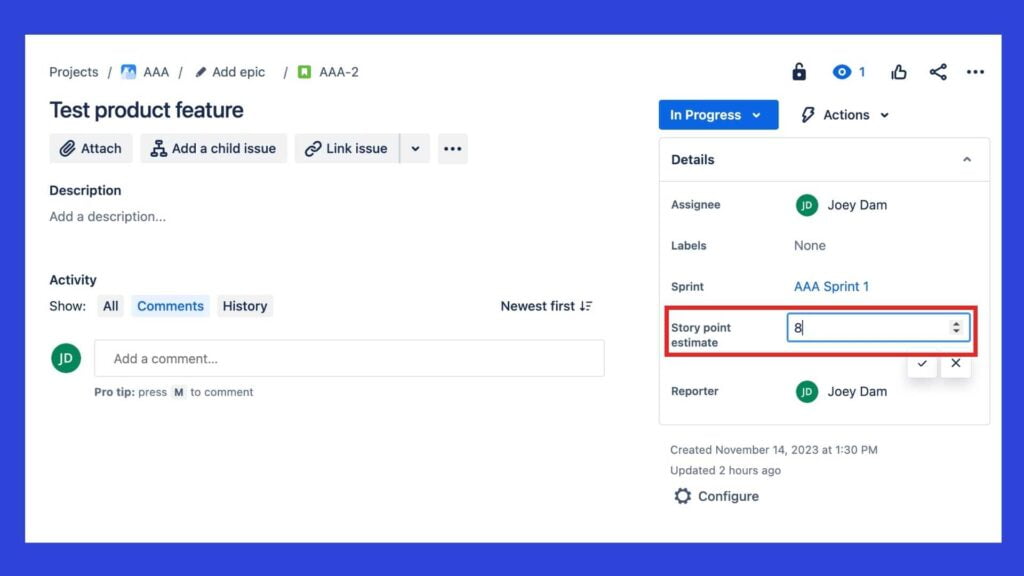
While Jira offers basic functionality for assigning Story Points to individual issues, this method can sometimes result in estimates that are subjective and lack team-wide consensus. To overcome this limitation and foster more accurate and collaborative story point estimation, AgileBox emerges as an ideal solution. It enhances the precision of estimates and bolsters team collaboration within the Jira environment. For a deeper understanding of how AgileBox can revolutionize story point estimation in Jira, continue reading for more detailed information.
Estimate Story Points more effectively with AgileBox in Jira
What is AgileBox in Jira?
AgileBox in Jira is an integrated tool designed to enhance Agile project management within the Jira platform. It provides features such as Planning Poker, retrospectives, and daily standup facilitation, specifically tailored for software development teams using Jira.
The planning Poker feature of AgileBox revolutionizes the process of estimating story points within Jira. It simplifies the estimation of effort and risks associated with project phases, enhancing accuracy and team collaboration.
This feature enables real-time collaboration among team members to collectively estimate story points. It fosters active participation from all team members in the estimation and discussion process, leading to highly accurate estimates. Besides that, enhances communication, encourages initiative, and promotes effective teamwork among team members.
Step-by-Step Guide to Estimating Story Points in Jira with AgileBox
To estimate story points with Planning Poker on Jira, you can follow these steps:
Step 1: Downloading Planning Poker for Jira
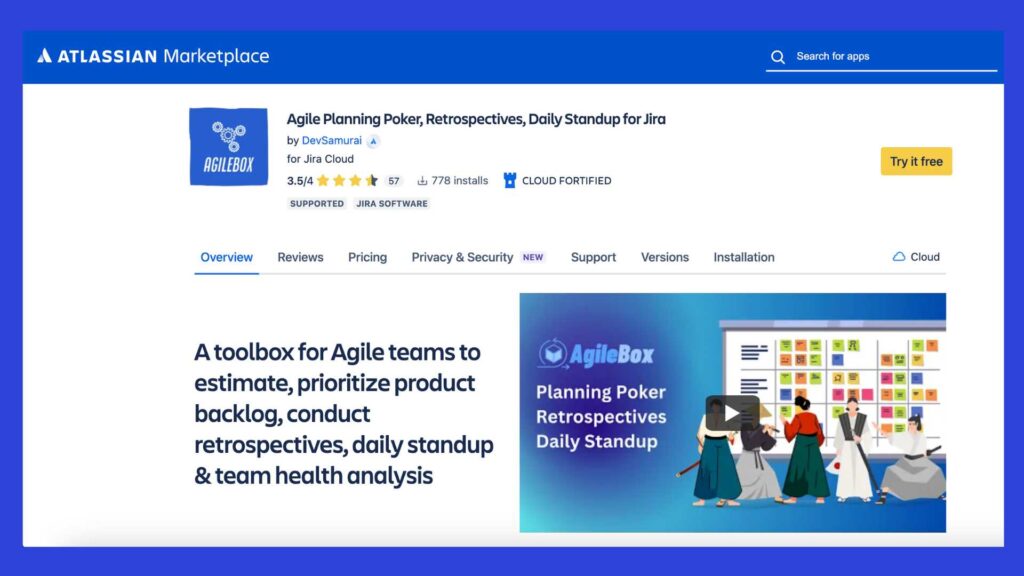
- You can download Planning Poker for Jira by clicking Agile Planning Poker, Retrospectives, Daily Standup for Jira.
- Then, find the AgileBox icon on the left side menu of your project.
Step 2: Create a New Planning Poker Game
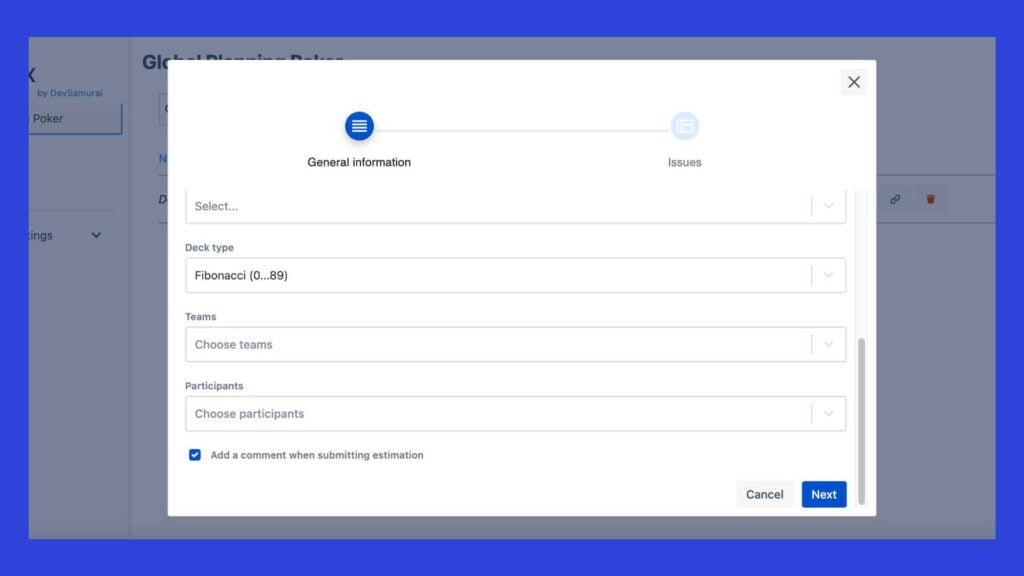
- You can create by clicking on the New Game button
- Then fill in the game details, choosing the deck type that suits your team best (Fibonacci sequence, T-shirt size, or Custom deck)
- Drag and drop unestimated issues from your project backlog into the Picked Issues column.
Step 3: Start the Estimation Process

Select the issues you want to estimate → Click the Start button to activate the countdown timer → Team members then pick suitable cards to represent their story point estimation.
- If there is consensus (all cards show the same value), the facilitator records the estimate and moves to the next item.
- If there is no consensus (different card values), the facilitator prompts team members with the highest and lowest estimates to discuss their reasoning, encouraging a revision of estimates if necessary.
-> Repeat until all issues are estimated.
Step 4: Create Sprint (optional)
AgileBox supports the Create Sprint option within the app. This helps the team quickly create a new sprint after the estimation section without leaving the app.
Click on the Create Sprint button on the Estimated column → Drag and drop the issues you want to put into the next sprint → Click Create and fill in the Sprit details
For more details please click on User Guide
Conclusion
In conclusion, understanding and effectively applying story point estimation is crucial in Agile project management. This article has provided insights into what story points are, their significance, and how tools like Planning Poker can enhance estimation accuracy. Embracing these practices leads to more efficient project planning and execution, ultimately driving project success.
Whether you’re a seasoned Agile professional or new to the field, mastering story point estimation is a valuable skill that streamlines workflows and fosters better team collaboration. As Agile methodologies continue to evolve, staying adept in these techniques will be key to managing dynamic and successful projects.





